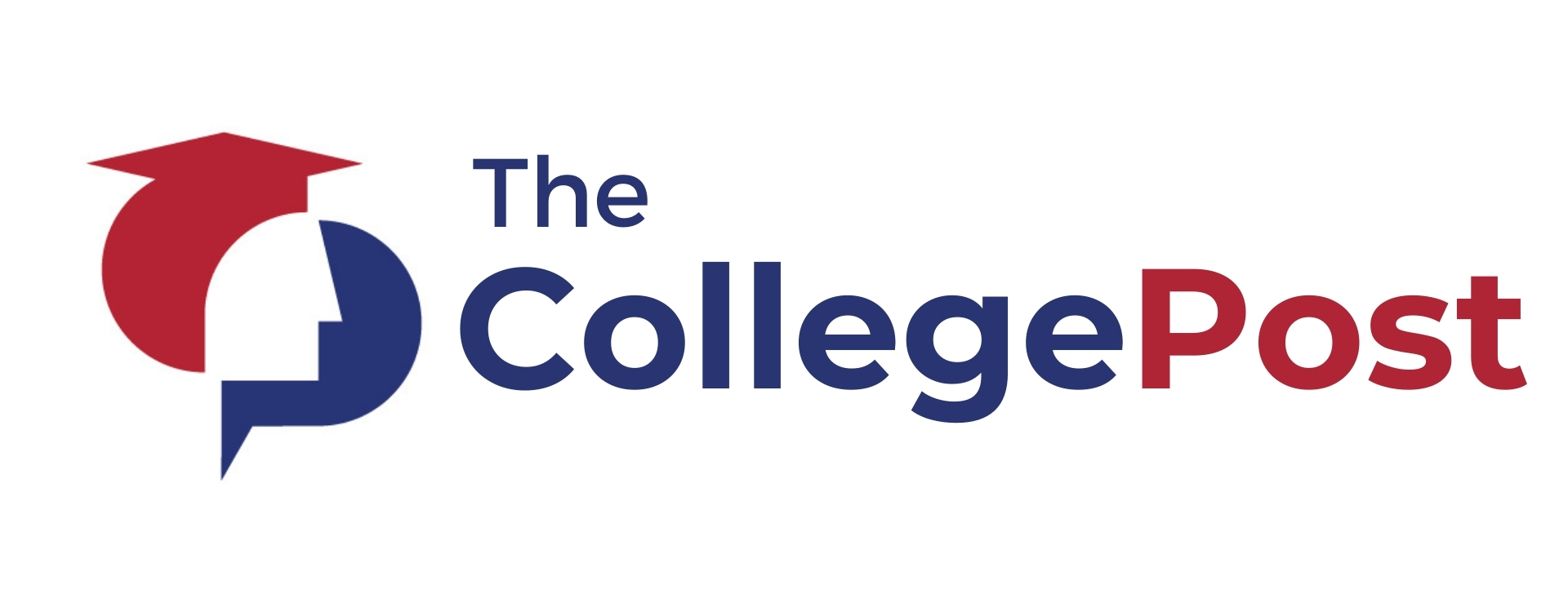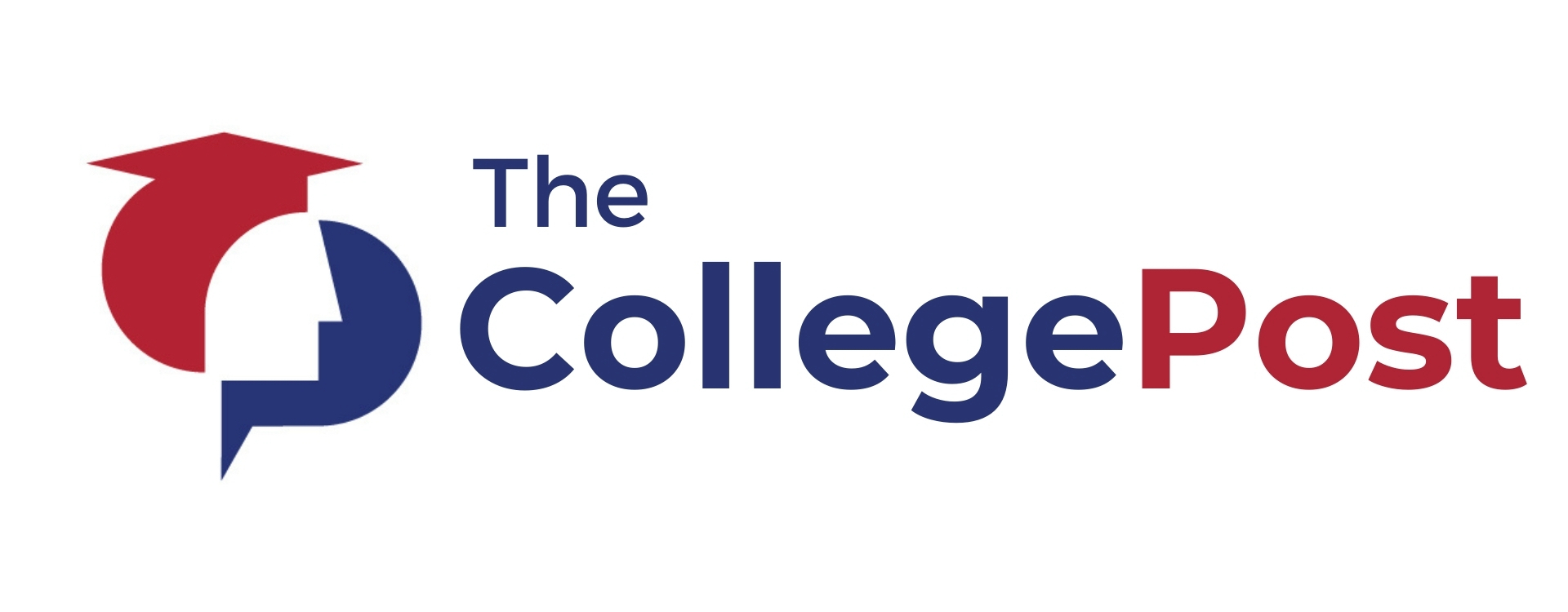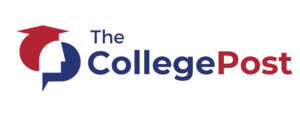What can make lessons stick to your brain like gum on a shoe? The answer: using the best note-taking methods for college. 📓
Jotting things down boosts memory recall because you’re actively interacting with the lessons you learn as you list, summarize, question, and analyze right away instead of mindlessly consuming information. 🧠
But even if you’re expected to take down notes during class or aid your memory when studying alone, note-taking methods that match your learning style, topic, and time constraints are rarely taught.
That ends today! Check out the 11 best note-taking methods for college students (with tips on how to write faster) to ace your exams. ✍️
- 1. The Cornell Method
- 2. The Outline Method
- 3. The Charting Method
- 4. The Map Method
- 5. The Boxing Method
- 6. The Sentence Method
- 7. The Flow Notes Method
- 8. The Structured Analysis Method
- 9. The Question, Evidence, Conclusion (QEC) Method
- 10. The Read, Encode, Annotate, Ponder (REAP) Method
- 11. The Write-on-Slides Method
- How to Write Notes Quickly
- Handwritten vs. Typed Notes: Which is Best for College Students?
- 11 Best Note-Taking Methods for College Students: Frequently Asked Questions
1. The Cornell Method
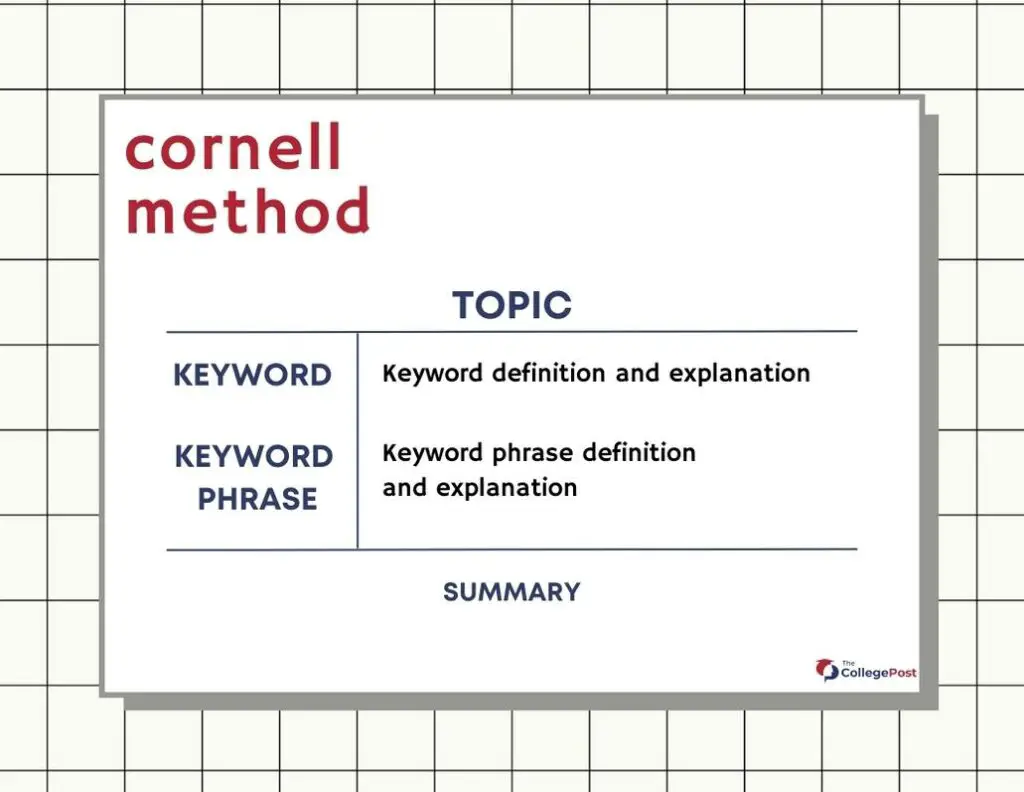
Are you pressed for time when it comes to reviewing mind-boggling concepts and ideas? Cornell Professor Walter Pauk created the Cornell Method to help students just like you! 🛟
This note-taking method lets you organize your notes as you write them, which comes in handy for easily identifying key elements and explanations during reviewing time.
The method starts when you draw two unequal columns in your notebook: 70 percent of space on the right side for the detailed explanations and 30 percent of space on the left side for the cues or keywords that sum up your notes on the right side. 📓
Keep a horizontal space at the bottom of the page for a summary section to recap what you’ve learned. During your review, you can cover the notes section and explain the topics in your own words based on the cues you wrote. 🗣️
Pros:
✅ Sums up information using cues that can be handy during a review
✅ Keeps your notes clean and organized
✅ Best used for organized lectures or book chapters with a central theme or topic
Cons:
❌ Space may be cramped depending on the volume of information, so you need to use symbols and abbreviations to maximize space and keep up with your professor’s speed
❌ Requires more time to summarize and organize ideas
❌ Doesn’t directly show relationships between concepts
2. The Outline Method
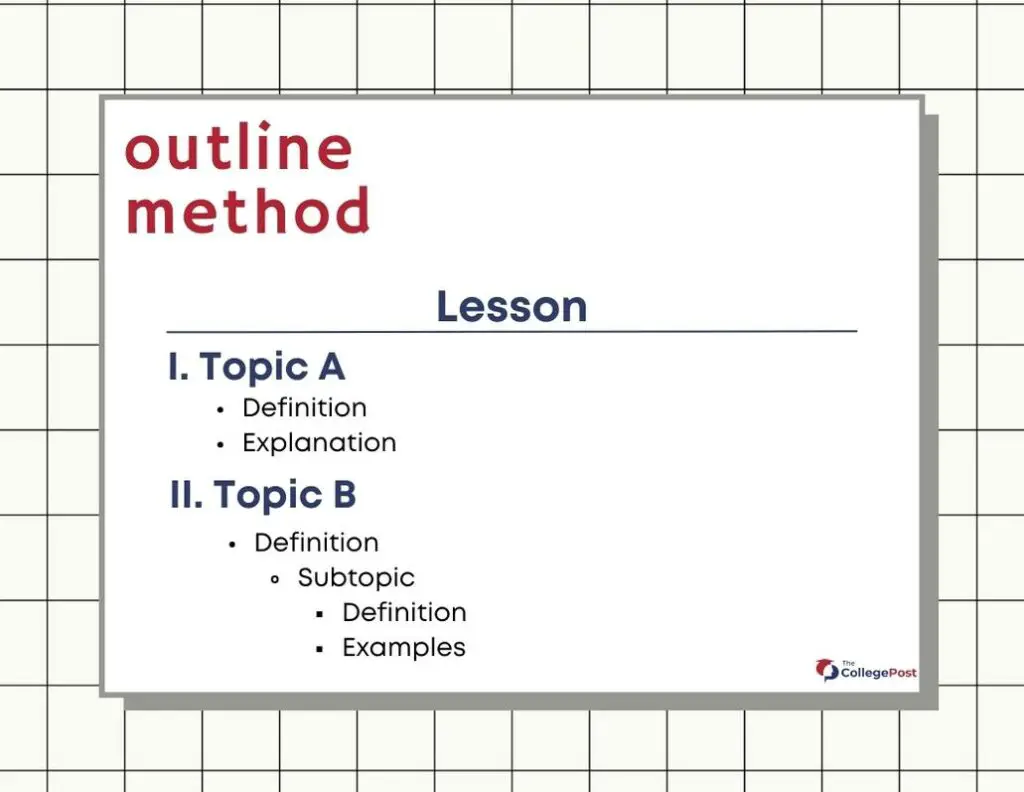
Probably the easiest and most common note-taking technique for college students, the Outline Method involves creating a linear hierarchy of the lesson’s main points.
This method is typically the starting point of students learning how to take notes because it connects the dots between topics and summarizes the main points. Plus, you can convert the topics into handy quiz questions! 😄
Create a structured outline by jotting down the main point on the left side of the page. Then, make a right indent below it to write supporting details or subtopics. Rinse and repeat for every point and explanation. 🧼
Keep your notes tight instead of block-heavy when you stick to one to two sentences per point.📜 Lastly, don’t forget to use bullet points or numbered lists for a clear order of ideas.
Pros:
✅ Adopts an easy-to-follow structure with no need to draw templates
✅ Helps identify relationships between different ideas
✅ Best for planning projects or essay outlines or writing summaries from your study sessions
Cons:
❌ Ineffective if the lecture is too fast or doesn’t follow a specific structure
❌ Inappropriate for lectures involving formulas, charts, and diagrams (such as mathematics and chemistry)
3. The Charting Method
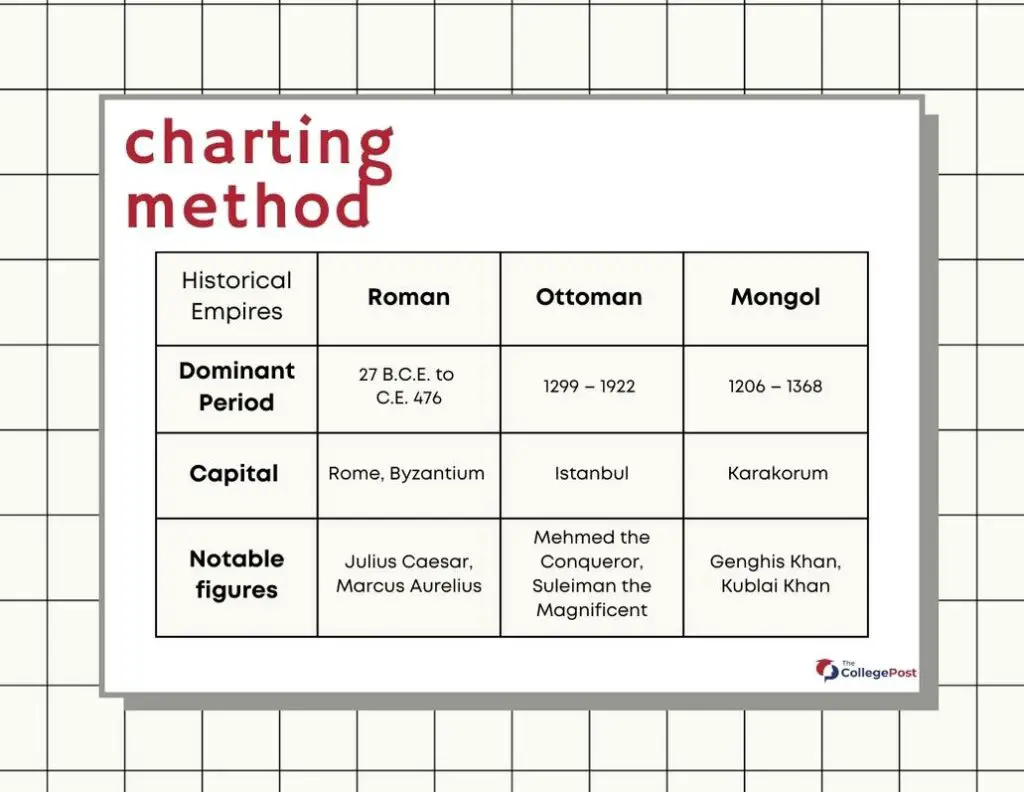
This method (also known as the Matrix Method) helps you battle mental strain and absorb heavy concepts by mapping out information in an easy-to-read table. 🛟
The charting method table lets you see an overview of the facts and relationships between different items under a central theme in one sheet and cut down on review time.👍
How do you start? First, figure out the categories you want to include in your hand-drawn columns (if you are taking notes on a computer, you can use Excel or Google Sheets). For example, communications majors comparing camera angles can list the different types of camera angles in the first column, descriptions in the second, and tips and tricks in the third.
Then, draw the corresponding rows and columns needed to fit those categories and write away! Handwriting multiple points in many rows and columns may take up lots of space, so use symbols and abbreviations or use a bond paper that you can bind with other notes later. 📁
Pros:
✅ Allows you to easily compare topics: similarities and differences, tips and tricks, etc.
✅ Easy to condense and review the information per category
✅ Best used for topics where heavy memorization is required
Cons:
❌ Not suitable for mathematical equations
❌ Can be time-consuming to create and update charts during fast-paced lectures
4. The Map Method

Calling visual learners: the map note-taking method is for you! 🗺️ Make sense of floating ideas by tying them together in a map to view how one relates to the others.
Keep up with your anatomy class or any single topic with multiple details by using a visual aid instead of trying to capture everything in huge blocks of text and ending up overwhelmed. 😵💫
Write the main topic at the top or middle of your paper — whatever works best for you — then branch out this idea into subtopics. This creates visible pathways of information that connect concepts to strengthen your understanding.
Use different colors, lines, shapes, and symbols to signify relationships and categories, maximize space, and organize everything. Your creativity is the only limit! 🖍️
TIP: Use the Outline Method or other note-taking techniques while studying and then transfer your cleaned-up notes using the Map Method to test your comprehension and prepare quick review notes.
Pros:
✅ An easy-to-follow visual aid showing the big picture and the nitty-gritty details on one page
✅ Encourages active learning during lectures and studying
✅ Best for topics with a central theme with multiple subtopics and connecting ideas
Cons:
❌ May take up a lot of space in your notebook
❌ Not ideal for fast-paced and disorganized lectures
❌ Prone to confusion or misunderstanding if one piece of information is misplaced or mistaken
5. The Boxing Method

Ready to pack a punch in your note-taking game? The Boxing Method might be your new friend since it allows you to cluster information in neat boxes. 📦
Visual learners will appreciate this method because topics are neatly separated from each other in customizable boxes, resulting in an aesthetically pleasing review guide. 😊
The process is simple: dedicate one box per topic to visually separate different ideas and concepts in vertical or horizontal order. Within the box, you can use the Outline Method to jot down the main topic and write down its definition or supporting details with a right indent below it. 👍
Keep everything neat and organized with the help of touch-screen gadgets like an iPad to easily resize or reorder your boxes and zoom in to focus on one topic at a time during review. 📱
Pros:
✅ Neatly organizes notes in boxes to guide your eyes to focus
✅ Ideal for visual learners who like to categorize ideas
✅ Takes advantage of digital note-taking apps
Cons:
❌ Might get messy if you didn’t allot the right space (for pen and paper note-takers)
❌ May be ineffective for fast-paced or cluttered discussions
6. The Sentence Method
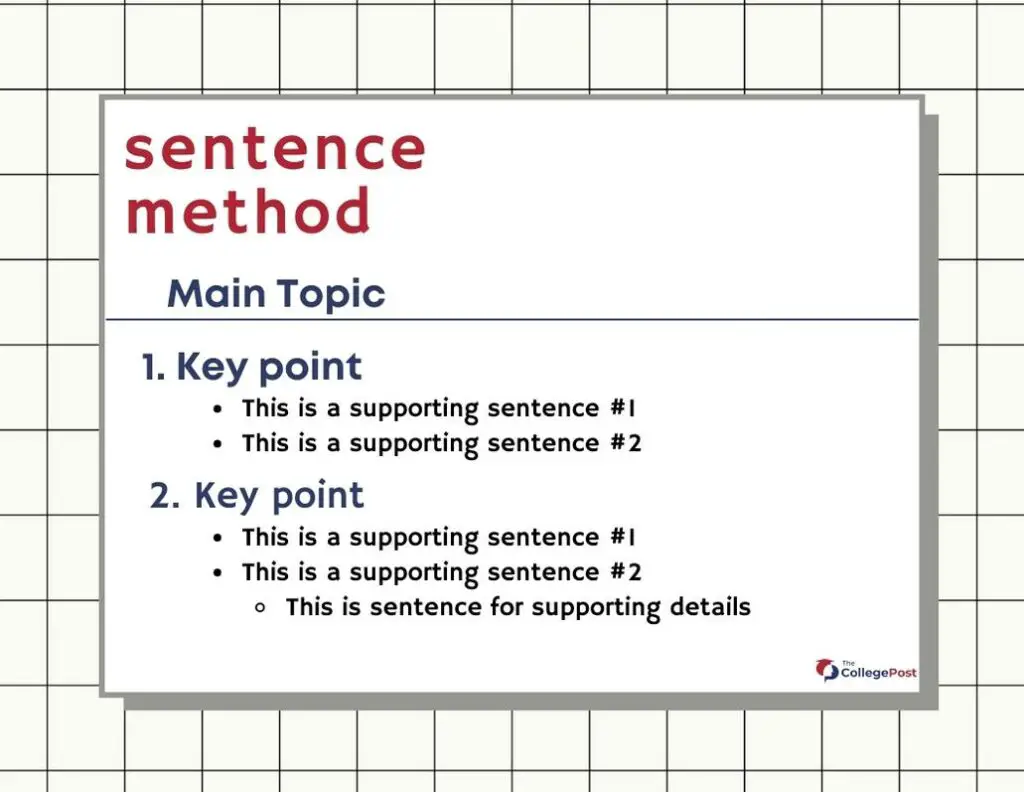
Write like the wind when you try the sentence note-taking method! 💨 How? Use symbols and shortcuts to catch up on fast-paced lectures or write in cursive to capture uncommon ideas without losing information.
While there are more efficient note-taking strategies out there, this style can do a good job in rushed lectures where you’re pressed for time in drawing templates (especially if you arrived late in class). 😅
This method is simple as you only need to capture discussions word for word — which makes it ideal for lectures with unfamiliar or complicated concepts. ✍️ Write every topic introduced in a vertical line, but expect that it can lead to a heavy block of text.
Take some time after class to reorganize the main points and identify the relevant details to avoid getting overwhelmed. You can even use the other note-taking methods in this list to clean up your notes and filter out the key points for easy review. 😀
Pros:
✅ Requires no preparation (no tables, symbols, etc.)
✅ No frills and fuss type of note-taking method
✅ Can be used for any type of class
Cons:
❌ May require rewriting the main points using another method and be time-consuming
❌ May have difficulty in seeing the main points or concept relationships during review
❌ Requires you to be a fast-paced writer or typist
7. The Flow Notes Method
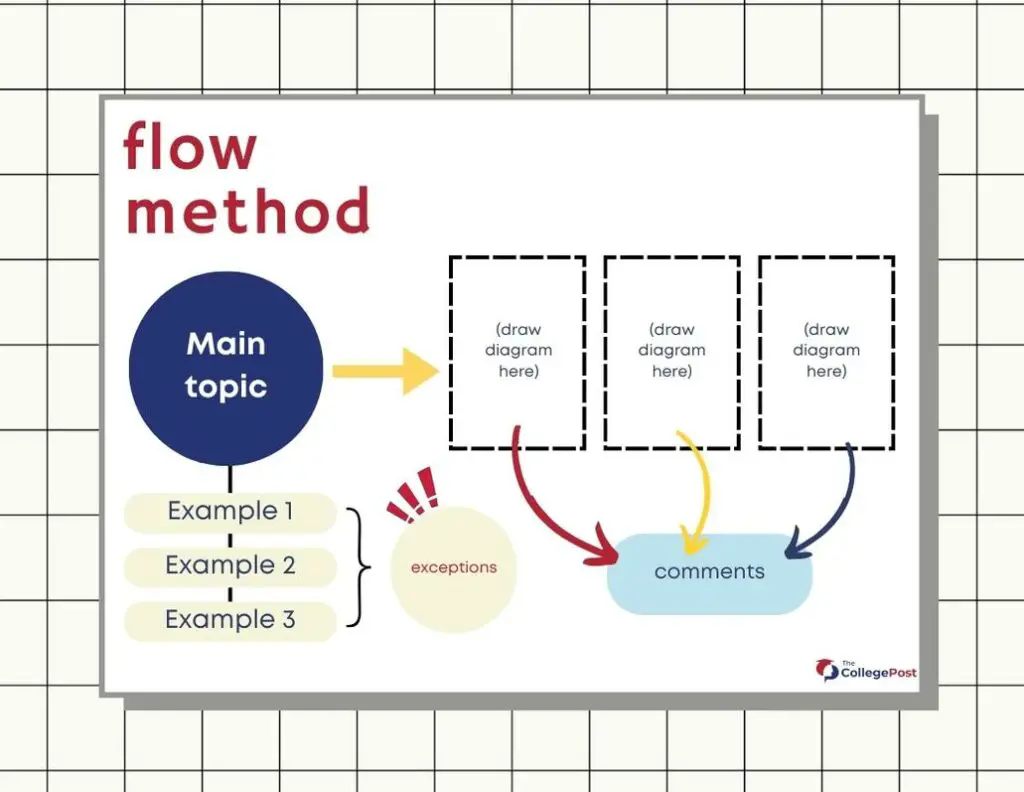
Are you in a brainstorming session with your project groupmates or in a roundtable discussion with your professor? The flow notes method is one of the perfect note-taking strategies for you. 🌊
The best part? Using this method means you can doodle, make graphs, or draw whatever you want to accommodate your collected ideas. You can even use this to make sense of your notes after reading the required materials for class. 👍
As its name suggests, you let your thoughts flow freely and use symbols or images to emphasize points or connect ideas for a coherent visual aid (even if it makes sense only to you) for review. 💭
TIP: Review previous notes or check the course syllabus before using the flow note-taking method in your upcoming class to have a better idea of which details to include and prioritize.
Just be careful to use this for topics where you already got the basics down pat, otherwise, your notes might end up confusing you even more in the face of unfamiliar concepts.
Pros:
✅ Helps you actively learn by putting things into your own words and connecting concepts
✅ Quick free-form visual aid
✅ Suitable for any type of topic (as long as it’s not completely new to you)
Cons:
❌ May lack showing connections between different topics, ideas, and arguments
❌ Can be misleading if you forgot key pieces of information while note-taking
❌ Only ideal if you already have a good understanding of your learning style
8. The Structured Analysis Method
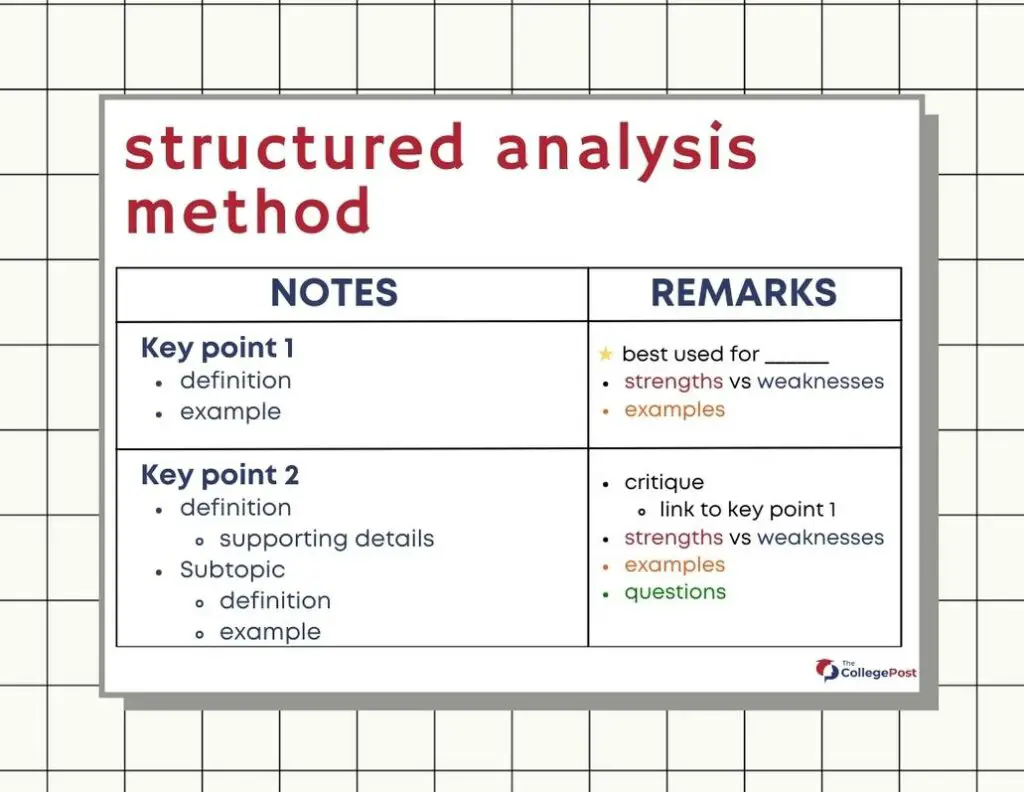
Overwhelmed by an overload of theory and concept analysis? Ease the mental pressure with the Structured Analysis technique, one of the best note-taking methods for college students. 🧠
This note-taking style helps you see an organized presentation of information about a particular concept to aid critical thinking. This method is useful for subjects like humanities where one concept can have different perspectives. 🔎
Draw a table with two columns, allotting a large space on the left for your notes and a smaller space on the right for your remarks (similar to the Cornell Method).
Use different colors or symbols to differentiate your remarks, whether it’s the strong and weak points, questions, comparisons, or other ideas to deepen your knowledge. This way, you can jot down your thoughts on a topic instead of just copying whatever your professor or your book said. 💯
Pros:
✅ Suitable for classes around ideas with strengths and weaknesses (like philosophy or sociology)
✅ Can be combined with other note-taking methods (e.g. you can use the Outline Method in the left column)
Cons:
❌ Page-consuming
❌ Requires intense focus as you’re note-taking and analyzing simultaneously
9. The Question, Evidence, Conclusion (QEC) Method
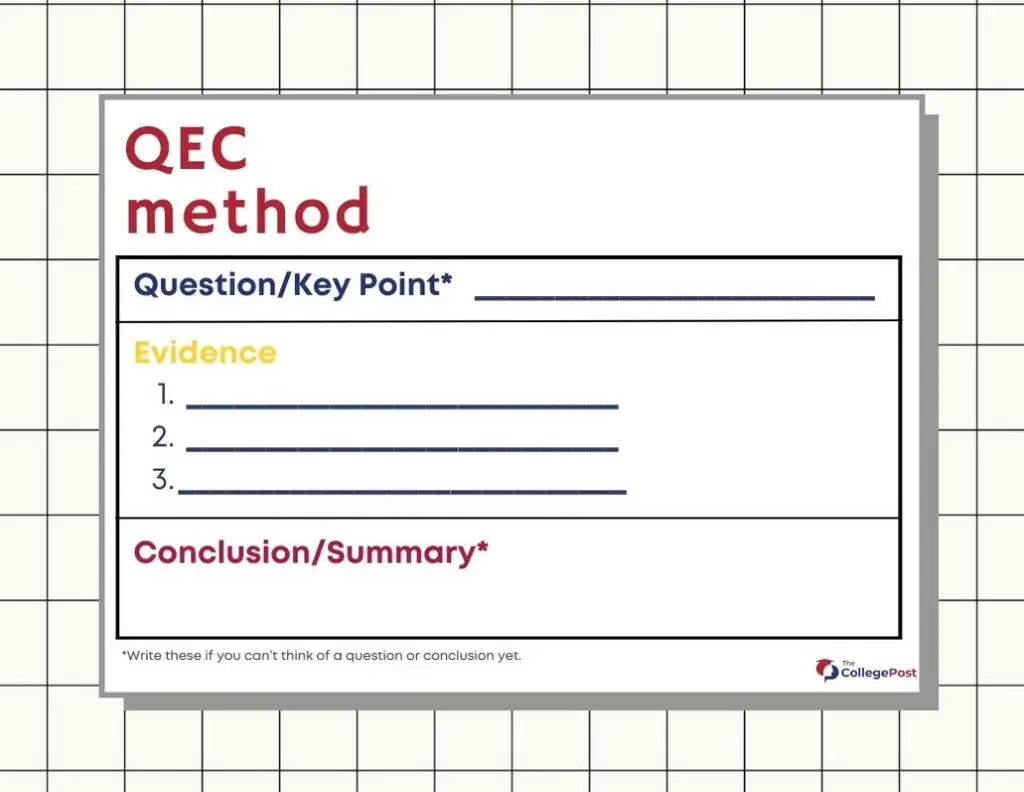
In his book How to Become a Straight-A Student, Cal Newport emphasized how the QEC technique is one of the best note-taking methods for classes that require deep thinking like philosophy and history. 💭
It’s because the method helps you view the bigger picture and identify knowledge gaps by questioning, which guides you on the particular area you need to pad with more studying to form an evidence-backed argument.
For this strategy, you put the main question in the first row, supporting details in the second, and the answer in the third. If you can’t think of a question yet, write the key point in the first row and the summary in the conclusion instead. 👍
Level up your note-taking game by color-coding each row for easy review. You can also use apps like Google Sheets and Excel to have the rows set and ready for note-taking. 📃
Pros:
✅ Helpful for reviewing argumentative concepts with open-ended answers (perfect for those studying humanities!)
✅ Suitable for planning projects and essays and reviewing the gaps in your knowledge after studying
Cons:
❌ May not be suitable for fast-paced and unstructured discussions
❌ Requires more focus to write everything down in full
10. The Read, Encode, Annotate, Ponder (REAP) Method
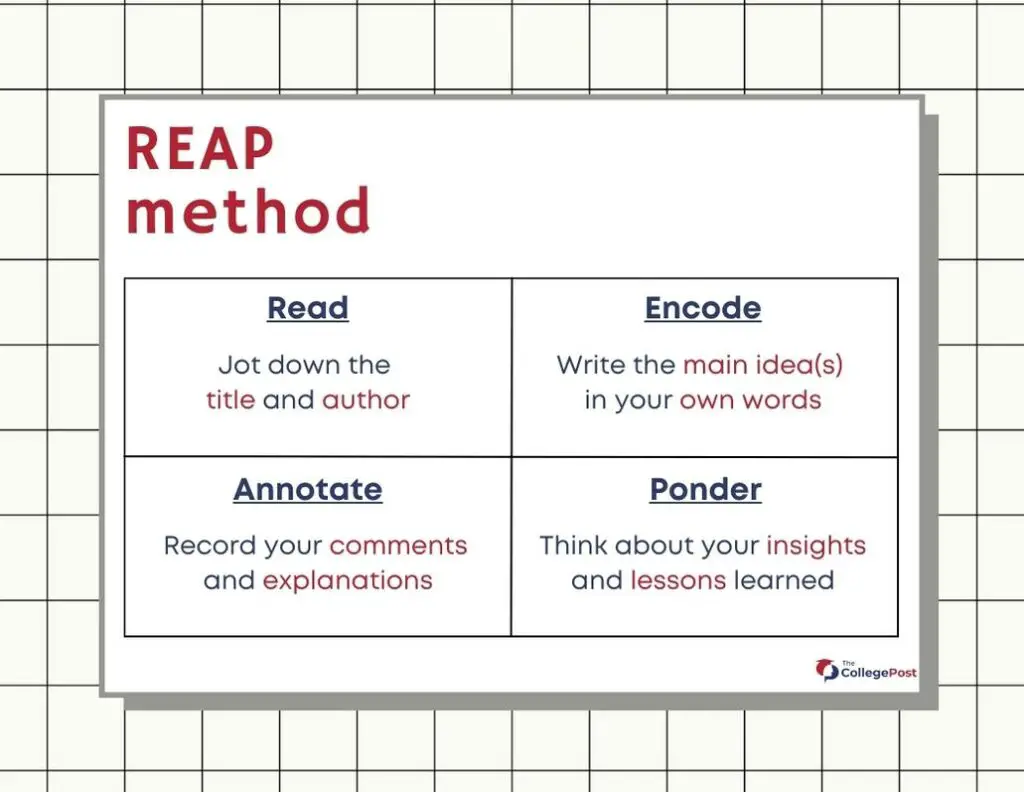
Test your level of comprehension when you follow the Read, Encode, Annotate, Ponder (REAP) method. While note-taking is usually for lectures, this can be a handy sidekick for students reading their required course materials. 😀
Instead of reading, highlighting, and leaving a few notes here and there, the REAP method gives you a format to tighten up your level of understanding by interacting with the material.
This note-taking method makes you an active reader in four stages: you read the lesson, encode it in your own words, annotate or write your remarks, and ponder or reflect on what you’ve worked on by sharing it with others. 👍
It’s also easy to do. Create one quadrant for each of the four stages and fill in the information. When annotating, try to write from different perspectives or use different annotation styles for a well-rounded analysis. ✅
Pros:
✅ Useful for all kinds of subjects, especially humanities and social sciences
✅ Boosts memory recall and comprehension
Cons:
❌ Time-consuming
❌ Can’t be used for lectures
11. The Write-on-Slides Method
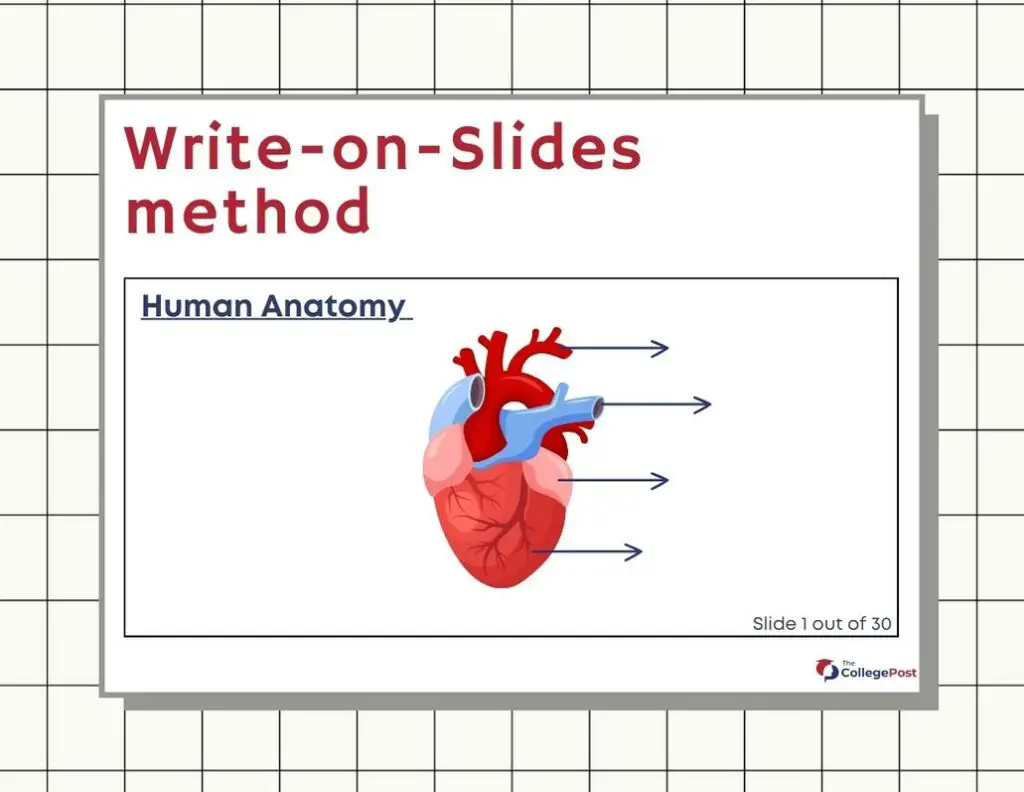
Some professors are a godsend for sending copies of slides to students before each class. If you’re one of the lucky ones, try your hand at using the write-on-slides method. 📄
This is a fairly straightforward way of learning note-taking since basic information is typically supplied and templates or drawings aren’t needed.
Instead of going mad by attempting to copy everything, you can just add information to the printouts. 📔 For example, you can jot down additional facts around a bar chart of radiation exposure rates in the US through the years instead of drawing the whole thing.
But, this only works in classes where the professor prepares detailed slides or allows you to make copies of them. 😁
Pros:
✅ Fewer distractions during lectures
✅ Can be combined with other note-taking methods
Cons:
❌ Can be unhelpful if the main lessons are discussed in class, so you’ll still have to do a lot of note-taking while listening
❌ May require extra preparation, like printing the slides before class if the professor sent a digital copy
How to Write Notes Quickly
Now that you know the best note-taking method for every subject and professor’s style, it’s time to upgrade your personal writing speed with these tips. 💨

Know the Feynman Technique
There’s a saying, “If you can’t explain it simply, you don’t understand it well enough.” Richard Feynman decided to help out by creating a process that breaks down a topic into easily digestible bits. 😀
This technique requires you to learn a topic inside and out and clearly explain it to someone who has no clue about the subject.
READ MORE: 11 Top Study Methods That Are Scientifically Proven to Work
The things you can’t explain in simple terms show the gaps in your knowledge, so you’ll know exactly what to review. Using this technique in your classes can eventually speed up your note-taking because you got the progression of ideas during the lesson.👍
Use Symbols and Abbreviations
Using symbols and abbreviations when taking notes can reduce your sentence (and the time it takes you to write one) by half without losing key points.
Here are some of the most common symbols and abbreviations to get you started:
| Symbol | Meaning | Abbreviation | Meaning |
| & | “and” | e.g. | “for example” |
| + | “with”, “plus”, “positive” | i.e. | “in other words” |
| – | “without”, “minus”, “negative” | w | “with” |
| = | “results in”, “equals to”, “the same as” | w/o | “without” |
| ≠ | “not equal to”, “not the same as” | v | “very” |
| < | “less than” | vs. | “versus” or “against” (used for comparisons) |
| > | “greater than” | b/c | “because” |
| ↑ | “up”, “increase”, “growth” | b/w | “between” |
| ↓ | “down”, “decrease”, “shrinkage” | n/a | “not applicable” |
| → | “leads to” | c. | “circa” |
| / | “per” | qty | “quantity” |
| ∴ | “therefore”, “thus” | “edu.” or “educ.” | “education” |
| ∵ | “because” | esp. | “especially” |
| # | “number” | et al. | “and others” |
| ~ | “approximately”, “about” | etc. | “and so on” |
| * | placed after a word, phrase, or sentence with an attached footnote | ex. | “example” |
| ✓ | “correct” | re: | “regarding” or “about” |
| x | “wrong”, “incorrect” | ff. | “the following items” |
| @ | “at” | p. | “page” |
Aside from these, you can also write down the first few letters of a word or skip the vowels. E.g. you can write “mktg” to mean “marketing” or “dev” to mean “development.” ✅
Note: Each study area has its own set of unique abbreviations, so familiarize yourself with them for faster note-taking per class.
Quick practice! Let’s rewrite this sentence using shortcut symbols:
“An American research study found that there is a positive correlation between exercise frequency and overall well-being, especially in individuals aged 40 and above.”
The shortened version will look like this: “US research found + correlation b/w exercise freq. & overall well-being, esp. in ppl aged 40+.”
Tips for Faster Note-taking on Paper
Quicken your writing pace by choosing pens with thin tips and a comfortable grip, like rollerballs or ballpoints, that have less drag on the paper. 🖊️
Another tip for faster note-taking on paper is to write in cursive because the letters are connected, so you won’t have to keep lifting your pen as often as you do with print handwriting. 📜
Tips for Faster Typing on Your Laptop
Type at lightning speed when you use proper hand placement on your keyboard. Use the key ridges on the letters “F” and “J” as a guide so you won’t have to keep checking the keyboard as you type. ⌨️
It also helps to enable autocorrect or Grammarly for quick and automatic adjustments to typos and to easily correct any grammar mistakes. 💻

Handwritten vs. Typed Notes: Which is Best for College Students?
By now, you may be wondering “Is it better to take notes on a laptop or paper in college?” 🤔
Handwritten and typed notes have always been pitted against each other regarding their efficiency in documentation and memory recall. While both methods have their pros and cons, it helps to first understand that note-taking consists of two functions: the ‘process’ of recording information in your own words and the ‘product’ of reviewing them. ✍️

A scientific study observed that typing notes helps you get more information than writing them down because you can quickly take screenshots of diagrams (which are harder to copy by hand) and type faster. Plus, you can easily edit typewritten notes to capture correct information without ending up with a scribbled mess. ⌨️
On the other hand, handwritten notes are still the best when it comes to reviewing since your brain actively processes lessons while you summarize instead of passively copying what’s being said word for word.
It’s best to choose a note-taking method matching your personal preference, the subject matter type, and your professor’s teaching style that gets you to revisit your notes. 💯
Now that you already know the best note-taking methods in college, try out each of them and see which techniques suit you best.
So what are you waiting for? Write, write, write! 📝
11 Best Note-Taking Methods for College Students: Frequently Asked Questions
Is it worth taking notes in college?
Yes, it’s important to take notes in college because it helps you focus to understand the lessons as they are discussed, which aids in memory recall and to review the key points later on.
What is the simplest way to take notes?
The simplest way to take notes is using the Outline Method where you jot down the key points in a structured manner and expand on them with bullet points. Another simple technique is the Sentence Method where you write down unfamiliar statements verbatim.
What are the key guidelines for note-taking?
1. Write in short phrases: Jot down key points and summarize lessons using your own words, symbols, and abbreviations.
2. Structure your notes: Use the Outline Method, Map Method, or any note-taking technique that matches your preference and the lesson’s presentation for easier memory recall.
3. Add visuals: Use colors and symbols to differentiate one piece of information from another.
Is it better to take notes on a laptop or paper in college?
It depends on the subject type. Handwritten notes might be better for humanities classes such as philosophy and history while typing notes can be helpful for STEM classes like biology or statistics to easily draw diagrams or take photos and paste them on your digital notes.
Should I use an app for note-taking?
You can use Microsoft Word, Google Docs, and other apps to speed up typing your notes in class or from reading a textbook. If you’re thinking of using an app, check out Notion, Evernote, Microsoft OneNote, or Obsidian.
What are the best note-taking methods for college?
1. The Cornell Method
2. The Outline Method
3. The Charting Method
4. The Map Method
5. The Boxing Method
6. The Sentence Method
7. The Flow Notes Method
8. The Structured Analysis Method
9. The Question, Evidence, and Conclusion (QEC) Method
10. The Read, Encode, Annotate, Ponder (REAP) Method
11. The Write-on-Slides Method
